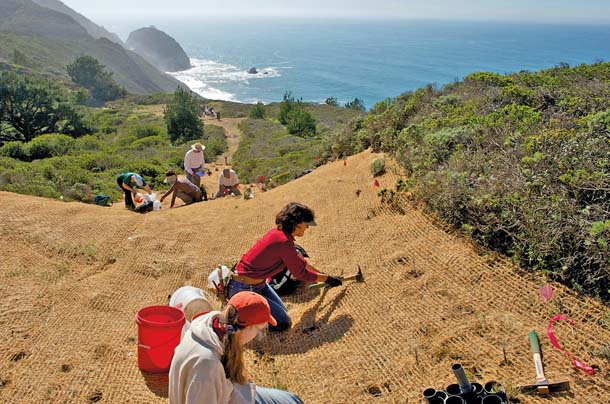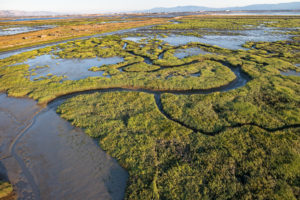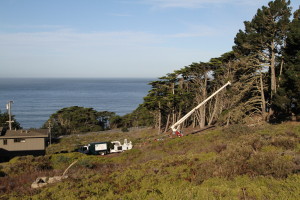Devil’s Slide, the precarious stretch of Highway 1 just south of Pacifica that’s as famous for landslides as it is for breathtaking views, has undergone a monumental transformation over the years. A pair of sleek, straight tunnels has been bored through San Pedro Mountain and will be opened to motorists this spring, replacing a white-knuckle stretch of unstable highway, which will be turned over to hikers and bicyclists, who can better enjoy the views without risking catastrophe.
But above and beyond the obvious structural improvements, the windswept bluffs of Pedro Point overlooking Devil’s Slide are enjoying a transformation of their own. The 246-acre park hosts a habitat now rare along the California coast – coastal prairie and shrubland home to dozens of species of native plants and wildlife. Spillover funds from the Devil’s Slide tunnel project will bring parking and improved trail access, but the habitat restoration here has come largely thanks to a dedicated, grassroots group of stewards.
“This place is pretty undiscovered, and it’s pretty wild,” says Lynn Adams, who heads the Pedro Point Headlands stewardship project, which was formed in 2009. “Over the past three years, we’ve become little watchdogs, and we’ve really started to get a handle on changing the [vegetation] back to how it’s supposed to be.”
In the 1960s and ’70s, Pedro Point Headlands served as the stomping grounds of a motorcycle club. Entire hillsides, weakened and scarred from tire tracks, crumbled away with the rains. To stabilize the hills, the motorcycle club planted Monterey pines, which, while native to other parts of the Central Coast, are an invasive species in Pacifica. It wasn’t long before the nonnative pine and eucalyptus trees began to dominate the area.
The Pacifica Land Trust took over the land in 1995. “It was great when the area first became a park, but we realized that without stewardship, it’s useless to people,” says Adams. “Now, as it becomes more accessible, it’s getting a much higher profile and people want to protect it.”
More than 500 people have participated in restoration efforts over the past three years. In addition to dedicated workdays to remove invasive plants, spread soil, and plant natives, volunteers host guided hikes and local experts lead bird walks.
Considerable work has been done since the land trust acquired the park, especially in curtailing the spread of the prevalent Monterey pines and eucalyptus. Outright removal of established groves can have adverse consequences, since they’ve come to support a variety of songbirds over the years, but smaller, sparsely distributed trees will be nipped in the bud.
“It’s all about understanding the area,” says Mike Vasey, a San Francisco State University lecturer and chief botanist with the project. He says the goal is a healthy mosaic of native dune scrub alongside existing groves. “Nature doesn’t care what was here before,” he adds. “As long as we work alongside what’s made a home here, control the erosion and the invasives, [the land] can support native species.”
Vasey points out different parts of the headlands: Some are completely washed out “slides” where major erosion has occurred. Others are rehabilitated hillsides sporting a dozen pastel colors of healthy native plants, the product of years of restoration efforts.
The current work is facilitated through an unusual marriage of long-term scientific research and everyday volunteerism. San Francisco State ecologist Tom Parker and graduate student Brian Peterson have designed the erosion control and revegetation methods, experimenting with a mix of adaptive management strategies to see which works best. Different sites have been chosen to test out different methods, from laying down straw and installing erosion-control fabric to seeing which native plants are most likely to establish a foothold in the soil.
“This is a really special place in that you have the ocean on three sides,” says Peterson. “Because of that relative isolation, it has its own specific climate and plant life, and we need to make people aware of that.”
That will be all the more important, he adds, when crowds of hikers start showing up. “This is going to be the hot spot of the Peninsula within the next couple of years,” says Peterson. “It’s important we get this healing process down first.”
Learn more at pedropointheadlands.org.





